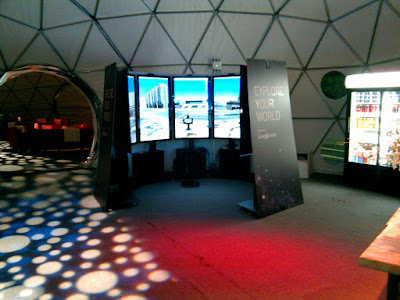LiquidGalaxyGallery
If you build your own Liquid Galaxy, post a link in the liquid-galaxy google group. We'd love to see what you come up with!
Andreu Ibanez built a liquid galaxy in Lleida, Spain:
Jack Reed at Georgia State University set up a liquid galaxy on the 48-screen Petit Science Center display wall. The 30" monitors each use 2650x1600 resolution, and the whole system is run by 4 Windows 7 machines using an Intel i7, 12gb ram, and 6 nVidia GPUs:
|
The Simulation Cube made by VisionaiR 3D ships standard with Google Earth:
Nick Skytland, Stuart Engelhardt and their team built a liquid galaxy at NASA's Johnson Space Center using 80/20 aluminum:
 |
|---|
Andrew Leahy's setups at UWS: (left) Mac controlling 3 Windows7 machines running a 3D sound demo, (right) 5 screen rig displaying NearMap imagery (via WMS) of the Brisbane River flooding:
 |
 |
|---|
paulh's 20-screen display wall, which he can control with a Kinect camera:
 |
|---|
jfedor's 5-screen galaxy:
wiki:video: cannot find YouTube video id within parameter "url".
| ABC News story on Liquid Galaxy | CNN | |
|---|---|---|
Mashable's video from TED 2010
|
The very first galaxy frame was made out of 2x4 lumber and plywood:
But we soon discovered that there was already a room just the right size to mount 57" LCD screens, and it became the original Liquid Galaxy:
A few months later we built the second-generation Liquid Galaxy, with a standalone, custom frame designed by Ji Lee:
We took it to a lot of great conferences. Here's a photo from Foo Camp 2009:
Our 3rd generation frame (the one you'll find in on this site) has independent stands that roll. Much easier to take on the road! Here's a photo from TED 2010:
Liquid Galaxy at the Google Japan office
Everone was disappointed when we took the Liquid Galaxy to a conference, so we set up a temporary 3-computer galaxy using 42" screens. It wasn't quite the same:
People often suggest that we use projectors instead of LCD screens, since that could eliminate the border between screens. The idea has promise, but projectors have their problems too. Most of them aren't designed to operate sideways, which would lead to a wide, narrow Liquid Galaxy design:






